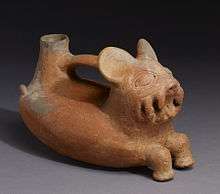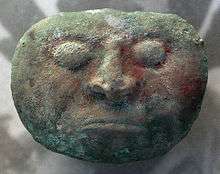Vicús culture

Vicús Feline Vessel from Walters Art Museum.
Vicús culture was an important early culture in Peru from 1000/200 BCE to 300/600 CE.[1][2] They lived in the Piura region in the northern Pacific coast of Peru.
Art

Vicus copper mask with red paint; 500 BC-400 AD, Kloster Allerheiligen, Schaffhausen, Switzerland
They were known for their work in ceramics, copper, and gold. Living mainly on the coastal deserts, they used the native clay and local dyes to produce natural and religious symbols; modern day pottery from the town of Chulucanas is said to closely resemble the ancient art.[3] They created Double spout and bridge vessel that created whistling sounds when pouring liquids.[2]
See also
| Wikimedia Commons has media related to Vicus culture. |
Notes
- ↑ "The Vicús Culture." Tampere Art Museum. (retrieved 3 May 2011)
- 1 2 Ransom, Brian (2000). "The Enigma of Whistling Water Jars in Pre-Columbian Ceramics."
- ↑ Chulucanas Pottery History
Further reading
- The Art of Precolumbian Gold: The Jan Mitchell Collection. New York: The Metropolitan Museum of Art. 1985. ISBN 9780297786276.
External links
- Vicús artwork, National Museum of the American Indian
- Vicus pottery, Wereldmuseum Rotterdam, The Netherlands.
This article is issued from Wikipedia - version of the 12/14/2015. The text is available under the Creative Commons Attribution/Share Alike but additional terms may apply for the media files.